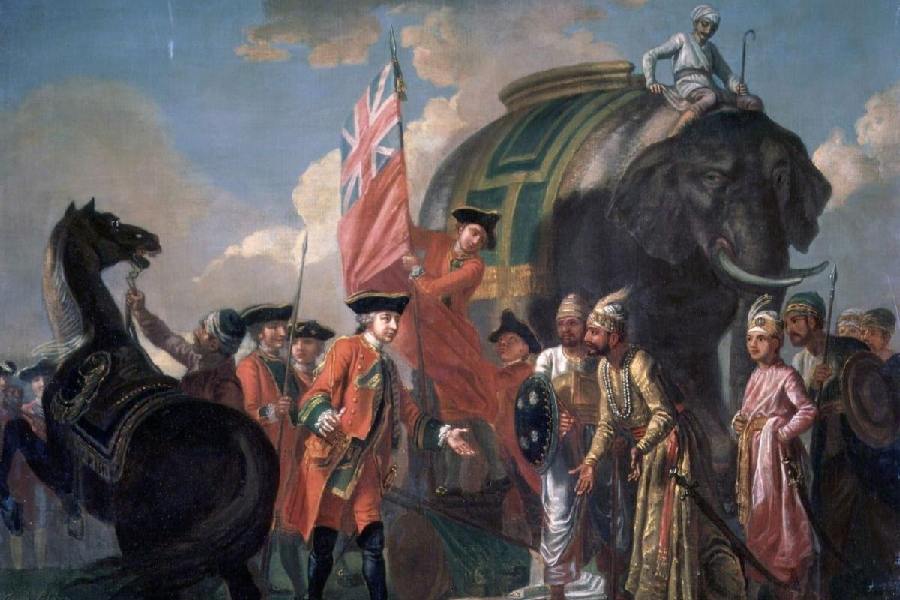On the 266th anniversary of the Battle of Plassey on June 23, the auditorium at Victoria Memorial Hall (VMH) turned into a “history class” of Presidency College.
It was a reunion of successive batches of history students of the college-turned-university as they turned up to listen to Emeritus Professor, Presidency University, Rajat Kanta Ray, whose most popular book was Palashir Sharajantra O Sekaler Samaj.
Ray reminded the audience that the British did not wage the Battle of Plassey to conquer India but simply to recover Calcutta, which had been taken by Nawab Siraj-ud-daulah, to restore the English trade in Bengal and, if luck permitted, to loot.
In a lecture titled Plassey 1757: Motivations and Outcomes, Ray said: “Admiral Watson and Colonel Clive did not fight for the Empire of India in 1756-57. Watson and Clive made a contract for 50:50 share of the spoils of war.”
Events after the death of Nawab Siraj-ud-daulah led to the eventual occupation of the Red Fort by Lord Wellesly’s forces in 1803.
“But that is not to say that the Battle of 1757 was fought for the supremacy of India, either by intent or in itself,” Ray said.
The Battle of Plassey was a Mughal conspiracy. “The Mughal elite looked to the East India Company’s troops as mercenaries for their own coup de tat,” said Ray.
Calling the Battle of Plassey a clash between an agrarian horse-borne autocrat and a seaborne armed corporation, Ray said: “There was a growth of vested interests in the court and there was an attempt at unfettered power by Siraj-ud-daulah. My teacher, Ashin Dasgupta, said it was ‘kayemi shartha versus nirankush kotritwa’.” Ray translated: “Vested interest versus unfettered power.”
The Dutch, the French and the East India Company had laid claim to extra-territorial jurisdiction. The Nawab intended to reduce them to the status of Armenian traders who did not have corporate and jurisdictional status, said the professor. Moreover, the East India Company and its servants both resorted to duty-free trade.
The latter, the company’s servants, were not entitled to do duty-free trade, the professor said.
According to Siraj-ud-daullah’s estimates, there was a loss of Rs 1.5 crore in duties on account of this from 1717-1756. More dangerously, the ships going to Calcutta exceeded the number of ships going further up the Ganges, to Murshidabad, Patna and Benaras. The Nawab intended to reduce the British to the status of Armenian traders, which did not please them.
Ray said the Nawab was a young man in a hurry. “He wanted absolute rulership but within the ambit of Mughal law and the realm of the Mughal emperor. His aim was to do away with extra-territorial jurisdiction in foreign ports like Chinsurah, Chandernagore and Calcutta. He occupied Calcutta and renamed it Alinagar to indicate the restoration of Mughal jurisdiction,” said the historian.
About the conspirators, Ray said they wanted power for themselves under a new Mughal governor, preferably one of themselves.
Jagat Seth, the banker, picked Mir Jafar as a proper Moghul candidate for the plot to remove Siraj. Mir Jafar, Rai Durlabh, another conspirator, agreed to join the British by deserting the Nawab. It was planned that in Plassey itself, they would leave Siraj and walk over to the British.
“It wasn’t easy to do that. There was an open field in between,” said the professor. They broke the agreement, did not join the British and remained neutral.
“Mir Jafar was a betrayer, not merely to Siraj but to Clive as well,” said Ray. Upon taking control of Calcutta, Siraj razed the English fortifications and imposed a fauzdar who restored the Mughal administration. By antagonising so many powerful interests, the Nawab lost his own life, opening the way to the rapacious plunder of Bengal and the collapse of the Mughals. Of the two opposing conceptions of Calcutta and Alinagar, the idea of Calcutta prevailed.
The principal conspirator Jagat Seth was drowned in the Ganges by Mir Qasim. Rai Durlabh was chased out of Murshidabad by his old friend Mir Jafar.
The Mughal elite was dislodged from their positions in administration, and their incomes from revenues stopped.
“The Mughal class disappeared around 1883 or so when Wellesly came to occupy Delhi,” said the professor.
For the British, the Plassey plunder was on, free trade resumed, and the East India Company fortunes soared.
The Bengal revenue surplus was useful for defeating Mysore and the Marathas. That in turn led to the occupation of Red Fort.
The British became the sovereign power of India. It was a long and twisted way from Plassey to Asahi, from the mango grove to Red Fort, from Clive to Wellesley, concluded Ray.
